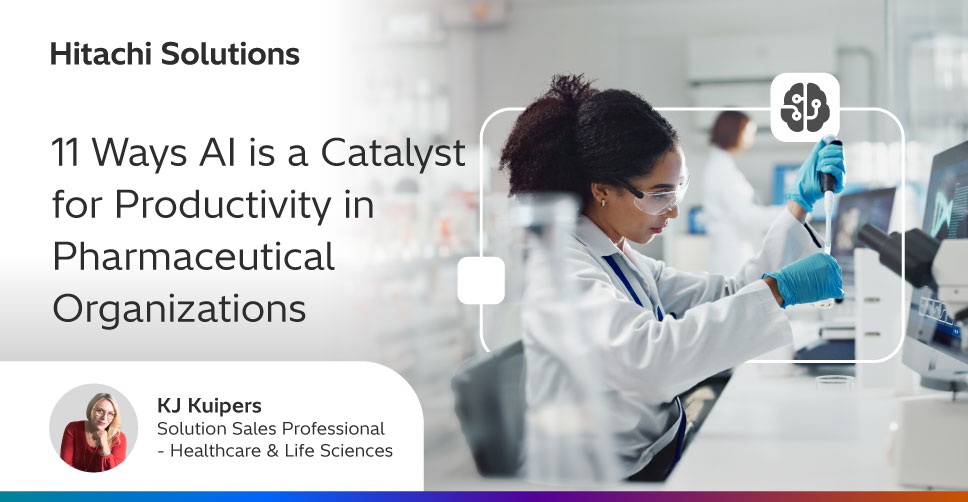

The content in this blog is an excerpt from our latest eBook. Want the full copy? Download here.
Artificial intelligence has moved from pilot to production in leading pharma organizations, elevating throughput and quality while compressing cycle times across plants and field teams. The near-term opportunity is to convert repetitive, document-heavy work into governed, AI-assisted workflows, freeing scarce talent to focus on decisions, not documentation.
In this blog, we’re highlighting how AI has the potential to impact employee and sales productivity.
Employee Productivity
- Real-time monitoring and predictive maintenance: Multimodal models fuse sensor signals (vibration, temperature, flow) with maintenance history to anticipate failures and recommend interventions. In analogous manufacturing “lighthouses,” applied AI has driven double-digital reductions in downtime and stabilized yield — results now attainable in Good Manufacturing Practices (GMP) environments with validated data pipelines and machine learning operations.
- Automated anomaly detection in electronic batch records (EBR): AI flags out-of-trend parameters and incomplete steps, enabling “review by exception” so quality teams spend minutes, not days, on release-critical issues. Industry guidance and practices support EBR-enabled exception review when implemented under appropriate controls.
- Faster, higher-quality deviation capture: Shop-floor copilots transcribe voice notes, structure them to deviation templates, and suggest likely root causes of corrective and preventative actions (CAPAs) based on historicals, accelerating triage while improving data completeness. McKinsey notes gen AI can reimagine deviation management end-to-end and auto-generate compliant reports aligned to corporate quality policies.
- Document generation with built-in compliance: Standard operating procedures, batch instructions, and validation summaries can be assembled from controlled templates and checked against 21 CFR Part 11/Annex 11 expectations and internal style guides before submission to quality. The FDA’s Part 11 framework and its 2024 electronic systems guidance define the guardrails for trustworthy electronic records and signatures — guardrails that AI workflows must observe.
- Knowledge retrieval for faster decisions: Retrieval-augmented generation (RAG) of SOPs, deviation libraries, laboratory management system (LIM) and manufacturing execution system (MES) artifacts, and maintenance manuals gives operators and quality assurance instant answers with citations, reducing line stoppages and handoffs. McKinsey’s latest perspective on agentic AI underscores the shift from “tool” to “coworker,” with agents coordinating tasks and escalating only what needs human judgment.
Sales Productivity & Performance
- Next-best-action recommendations: Models synthesize prescribing trends, access dynamics, scientific interest, and channel preferences to prioritize calls and content from healthcare professionals (HCPs), improving call planning and message pull-through. Analytics-enabled omnichannel models are a proven path to elevate HCP engagement.
- Adaptive learning and personalized coaching: AI builds individualized training plans for each rep based on performance gaps, therapeutic complexity, and objection patterns, accelerating ramp and maintaining message quality at scale.
- Personalized content delivery with compliant guardrails: Copilots recommend and assemble approved, indication-appropriate content for each interaction and channel, then log rationale for auditability. Emerging best practices in medical, legal, and regulatory review modernization show how AI can speed review while preserving control and traceability.
- Territory planning and trip reporting: AI automatically transcribes and converts field notes into structured trip reports (including accounts, clinical questions, and access issues), eliminating after-hours documentation and improving data completeness for managers and medical teams.
- Regulatory guardrails in the loop: Real-time checks help prevent off-label or non-compliant claims and ensure only approved language is used, supported by digital-record requirements under Part 11 for trustworthy logs and signatures.
- Competitive and market intelligence: Agents scan public sources for label changes, trial readouts, and formulary shifts, then surface implications for messaging and access strategy.
Pharmaceutical leaders know AI has the power to transform their industry and Hitachi Solutions brings the technical and industry experience to accelerate your transformation. Let us help you turn pilots into production, deliver measurable value, and build a durable foundation for what comes next!


